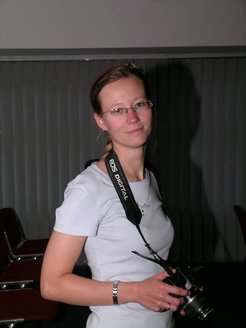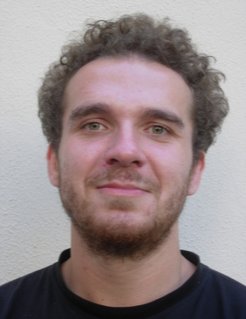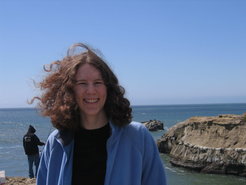Alumni 2010
Bagmeet Behera (9.2.) - Cassandra Fallscheer (9.2.) - Rosalind Skelton (25.2) - Aday Robaina (25.2)- Yolanda Sestayo de la Cerra (26.5.) - Christoph Federrath (7.6.) - Peter Melchior (8.6.) - Julian Merten (23.6.) - Giovanni Natale (16.7.) - Olaf Schulz (21.7.) - Kelly Foyle (13.10.) - Christian Schwab - Nicola Da Rio (13.10.) - Massimo Viola (15.10.) (16.10) - Andras Zsom (18.10.) - Benjamin Moster (2.11.) - Ronny Zhao-Geisler (15.11.) - Jean-Claude Waizmann (24.11.) - Tatiana Vasyunina (13.12.) - Olga Zacharopoulou (13.12.) - Denija Crnojevic (10.12.) - Baybars Külebi (17.12.)
Baybars Külebi (Turkey) 17.12.2010

Constraints on the origins of magnetic White Dwarfs (thesis pdf, 15MB)
The central theme of this work is the most frequent final stage of the evolution of magnetic stars, the Magnetic White Dwarfs (MWDs). Improved statistical investigations coming from new surveys and very precise observations of unique MWDs offer the possibility to test various hypotheses on the evolution of these objects. In the first part of our work we identify hydrogen-rich MWDs (DAHs) in the Sloan Digital Sky Survey (SDSS) and investigate the population statistics of all known DAHs in the SDSS. Additionally, we investigate the evolutionary histories of a few of these objects using constraints from the observations of their binary counterparts or through their membership in open clusters. In the second part of our work, we investigate the unique MWD REJ 0317-853, by a parallax measurement with the Hubble Space Telescope and by time resolved spectro-polarimetric modeling. We show that the assumption of centered magnetic dipoles for the field geometry is not correct for more than half of the objects in our sample; this is in particular true for REJ 0317-853 which shows a very uniform field during one rotation phase. This is validated by the first observation of cyclotron absorption in the polarization spectrum of a white dwarf, which is explained with a new model for the self-consistent physical treatment of this absorption process. Furthermore, we study the possible influence of magnetism on the mass loss during the stellar evolution and on the structure of the star which is of importance to understand the nature of the massive white dwarf REJ 0317-853.
Supervisor: Stefan Jordan (ARI)
Denija Crnojevic (Italy) 10.12.2010

Resolved stellar populations of dwarf galaxies in the Centaurus A/M83 group (thesis pdf, 47MB)
Dwarf galaxies, fundamental ingredients of galactic structures in our Universe, are ubiquitous and surprisingly heterogeneous systems. The study of such objects in nearby groups is a powerful way of investigating their formation and evolutionary mechanisms. The Centaurus A/M83 group is denser and in a more advanced evolutionary phase than our own Local Group, thus being an appealing target for the study of dwarf galaxies. Its more than 50 dwarf members, with different morphologies and stellar contents, can still be resolved into individual stars (at an average Galactocentric distance of ~4 Mpc). We use optical (HST/ACS) and near-infrared (VLT/ISAAC) photometric data to derive physical properties and evolutionary histories for sixteen dwarfs in this group. Specifically, the predominantly old populations of our target early-type dwarfs show metallicity contents that resemble what is found for Local Group members. However, they intriguingly contain lower intermediate-age population fractions than those found in morphologically similar dwarfs around the Milky Way, thus being more comparable to the M31 companions. We also apply our analysis techniques to the deeper photometric data available for M31 early-type dwarfs. The star formation histories derived for our star-forming late-type dwarf targets reveal that the star formation is quenched for galaxies currently found in the densest group regions. The time-dependent spatial distribution of their stellar populations points toward a stochastic star formation mode in these objects. Our results show that the evolution of dwarf galaxies depends on their mass but that it is, at the same time, heavily influenced by the surrounding environment. The Centaurus A/M83 group, along with other nearby galaxy groups, deserves further attention in order for us to ultimately gain deeper insights into the processes that regulate the evolution of dwarf galaxies.
Supervisor: Eva Grebel (ARI)
Massimo Viola (Italy) 15.10.2010

On shear and flexion measurements and properties of dark matter halos (thesis pdf, 7MB)
In this work we analyse the Kaiser-Squires-Broadhurst method (KSB) to estimate gravitational shear from surface-brightness moments of small and noisy galaxy images. We show how KSB relies on restrictive mathematical assumptions concerning the relation between convolved and unconvolved ellipticity, the shape of the telescope’s PSF as well as the relation between ellipticity and shear, neither of which hold in practise. We propose improvements to the original KSB relations and we demonstrate that this extension lowers substantially the biases in the shear measurements. Moreover we discuss the impossibility to weaken the assumption on the PSF shape in the KSB framework. For this reason we develop a novel method for weak-lensing measurements, DEIMOS, which is based on a mathematically exact deconvolution of the moments of the apparent brightness distribution of galaxies from the PSFs. We demonstrate the accuracy and capabilities of this new method with a set of specialized tests and show its competitive performance on the GREAT08 challenge data. Moreover we present a possible application of shear measurement for studying proper- ties of galaxy clusters based on linear filtering techniques to constrain the inner slope of the density profile of dark-matter halos. We find that under idealised assumptions, the inner slope is constrained to 15% if the halo concentration c is known, and to < 30% if not. If the signals of many halos can be stacked, their density profiles should thus be well constrained by the proposed linear filters with the advantage, in contrast with strong lensing analysis, to be insensitive to the cluster substructures.
Supervisor: Matthias Bartelmann (ITA)
Nicola Da Rio (Italy) 13.10.2010

An Optical Study of Young Stellar Clusters (thesis pdf, 11MB)
In the first part of this thesis a new analysis of the Orion Nebula Cluster, one of the most studied star-forming regions in the Galaxy, is presented. Based on multi-band optical photometry and spectroscopy obtained with the Wide-Field Imager (WFI) at the ESO/MPI 2.2-m telescope at La Silla Observatory, I study the systematic effects that bias the derivation of stellar parameters of pre-main sequence (PMS) stars. I derive the new H-R diagram of the entire region, and assign masses and ages to all the members. The age is found to be ∼ 2 − 3 Myr, older than previously estimated. I also confirm the presence of an age spread, and show how the previously found mass-age correlation can be affected by the sample incompleteness and uncertainties in the evolutionary models. In the second part of this thesis, I carry out a research on the low-mass stellar population of the young stellar cluster LH 95 in the Large Magellanic Cloud, based on deep optical photometry with the Advanced Camera for Surveys (ACS) onboard the Hubble Space Telescope; the deepest ever obtained toward this galaxy, down to V ≃ 28 mag. I isolate the PMS cluster population, and derive the first extragalactic Initial Mass Function (IMF) down to the subsolar regime. It shows a flattening below 1 M⊙, in agreement with the Galactic IMF once results are corrected for unresolved binarity. I study the age distribution of LH 95, introducing a statistical method to derive average age and age-spreads accounting simultaneously for unresolved binarity, differential extinction, variability, accretion and crowding of PMS stars. The best-fit solution for LH 95 suggests an age of ∼ 4 Myr with a gaussian age spread of σ ∼ 1.2 Myr. Finally, I study the early-type highmass stellar population of the cluster, through ground based spectroscopy obtained with the Fiber-fed Extended Range Optical Spectrograph (FEROS) at the ESO/MPI 2.2-m telescope at La Silla Observatory, and photometry from the 1-m telescope at Siding Spring Observatory. The derived stellar masses are combined with my results on the low-mass IMF of the cluster for the study of the most complete extragalactic IMF ever performed.
Supervisors: Dimitrios Gouliermis, Thomas Henning (MPIA)
Olga Zacharopoulou (Greece) 13.12.2010

On the origin of the unusually hard gamma-ray spectra of TeV blazars (thesis pdf, 2MB)
The observed VHE spectra from blazars may be significantly modified due to interactions of $gamma$-rays with intergalactic radiation fields. To study the emission production in these kind of objects, one should reconstruct the intrinsic spectra using an Extragalactic Background Light (EBL) model. Interestingly, this correction often leads to unusually hard spectra. In this dissertation we take into account the EBL absorption by using different models to reconstruct blazars' spectra and we study the formation of broad-band spectra in the framework of a proton synchrotron scenario with non-negligible gamma-gamma absorption in the production region. This internal absorption leads to rather hard VHE spectra. Moreover, a significant fraction of the energy absorbed in the VHE band may be transferred into secondary electron-positron pairs providing an additional radiation channel that explains the observed radiation in the Optical/X-ray regimes. In order to demonstrate the potential of the model, we model two relatively distant blazars, 1ES 0229+200 (z=0.1396) and 3C 66A (z=0.444). In addition, we perform numerical simulations using relativistic MHD in time variable injection setup, in an attempt to understand better the conditions under which radiation is produced in relativistic jets.
Supervisor: Felix Aharonian (MPIK)
Tatiana Vasyunina (Russia) 13.12.2010

Very early stages of massive stars (thesis pdf, 27MB)
The goal of this thesis work is to investigate the initial conditions and the early phases of the formation of high{mass stars by means of dedicated observational studies. We consider two object classes: infrared dark clouds (IRDCs), and a subsequent stage characterized by the presence of young embedded (proto-)stellar clusters. First, we estimate masses and column densities for a completely new sample of southern IRDCs, utilizing our own millimeter continuum emission maps as well as Spitzer satellite data. The parameters we derive show that IRDCs from our sample have the potential to form not only low- and intermediate-mass stars, but can also be the birth places of massive stars. In particular, the comparison of our results with previously obtained data for low-mass starless cores shows a clear trend for IRDCs to have systematically higher column densities. The interpolated IRDC peak column densities exceed the threshold for the onset of massive star formation previously advocated by theoretical studies. We also critically evaluate the limitations of the applied emission and extinction methods. Second, we investigate the physical conditions and the chemical composition of the dense gas within the IRDCs of our sample by means of a multi{line molecular spectroscopy analysis. All the clouds have complex HCO+ line proles, and we detect SiO emission in some clouds. These findings mark the presence of infall and out ow motions in at least some parts of the IRDCs, and hence, ongoing star formation. In comparison with low-mass starless cores, the IRDCs have broader and more intense lines. Thus, they may be characterised by more turbulent conditions. Nevertheless, we find a tendency for the IRDCs to have molecular abundances similar to the case of low-mass starless cores. This indicates similar chemical initial conditions for low- and high-mass star-forming regions. Finally, we study the stellar composition and environmental conditions in the young embedded cluster IRAS 06058+2138. We perform an analysis of all the available data, covering the near- and mid-infrared as well as the centimeter and millimeter wavelength range. In particular new VLT/SINFONI integral{field spectroscopy data have played a pivotal role. We identify three star-forming clusters at diㄦent evolutionary stages. Comparing the relative ages of these clusters and their relative locations, we conclude that triggering could not have led to the cluster configuration we see in the region. Thus, we assume a merely sequential star-formation scenario for this region. With this study, we also demonstrate the importance of a multi{wavelength approach. Combining data at diㄦent wavelengths allows us to investigate both the more evolved stellar population, as well as very young embedded objects, and hence, to reconstruct the star-forming history of structured cluster environments.
Supervisor: Thomas Henning (MPIA)
Jean-Claude Waizmann (Germany) 24.11.2010

On finding galaxy clusters with Planck and the spherical collapse model in different Dark Energy cosmologies (thesis pdf, 20MB)
One of the main objectives of the Planck mission is to perform a full-sky cluster survey based on the Sunyaev-Zel'dovich (SZ) effect, which leads to the question of how such a survey would be affected by cosmological models with a different history of structure formation than LCDM. To answer this question, I developed a fast semi-analytic approach for simulating full-sky maps of the Compton-y parameter, ready to be fed into a realistic simulation pipeline. I also implemented a filter and detection pipeline based on spherical multi-frequency matched filters, that was used to study the expected SZ cluster sample of Planck. It turned out that realistic samples will comprise ~1000 clusters at low rate of contamination, significantly lower than originally anticipated. Driven by wrong estimates of the impact of early dark energy models on structure formation, we studied the spherical collapse model in dark energy model, finding that models with varying equation-of-state have a negligible impact on the structure formation. Yet, the different expansion history for the different models can be detected via volume effects, when counting objects in a known volume. Furthermore, it turned out that the different expansion history strongly affects the angular SZ power spectra for the various models, making them an interesting tool to distinguish and constrain alternative cosmologies.
Supervisor: Matthias Bartelmann (ITA)
Andras Zsom (Hungary) 18.10.2010

Monte Carlo models of dust coagulation (thesis pdf, 40MB)
The thesis deals with the first stage of planet formation, namely dust coagulation from micron to millimeter sizes in circumstellar disks. For the first time, we collect and compile the recent laboratory experiments on dust aggregates into a collision model that can be implemented into dust coagulation models. We put this model into a Monte Carlo code that uses representative particles to simulate dust evolution. Simulations are performed using three different disk models in a local box (0D) located at 1 AU distance from the central star. We find that the dust evolution does not follow the previously assumed growth-fragmentation cycle, but growth is halted by bouncing before the fragmentation regime is reached. We call this the bouncing barrier which is an additional obstacle during the already complex formation process of planetesimals. The absence of the growth-fragmentation cycle and the halted growth has two important consequences for planet formation. 1) It is observed that disk atmospheres are dusty throughout their lifetime. Previous models concluded that the small, continuously produced fragments can keep the disk atmospheres dusty. We however show that small fragments are not produced because bouncing prevents fragmentation. 2) As particles do not reach the fragmentation barrier, their sizes are smaller compared to the sizes reached in previous dust models. Forming planetesimals from such tiny aggregates is a challenging task. We decided to investigate point 1) in more detail. A vertical column of a disk (1D) is modeled including the sedimentation of the particles. We find that already intermediate levels of turbulence can prevent particles settling to the midplane. We also find that, due to bouncing, the particle size distribution is narrow and homogenous as a function of height in the disk. This finding has important implications for observations. If it is reasonable to assume that the turbulence is constant as a function of height, the particles observed at the disk atmospheres have the same properties as the ones at the midplane.
Supervisor: Kees Dullemond (MPIA)
Ronny Zhao-Geisler (Germany) 15.11.2010

The surprising mid-IR appearance of the Asymptotic Giant Branch stars R Aql, R Aqr, R Hya, V Hya and W Hya: molecular and dust shell diameters and their pulsation dependence probed with the MIDI interferometer (thesis pdf, 20MB)
Asymptotic Giant Branch (AGB) stars are the main distributors of dust into the interstellar medium due to their high mass loss rates in combination with an effective dust condensation. It is therefore important to understand the dust formation process and sequence in their extended atmosphere. The wind of these stars is driven by strong stellar pulsation in combination with radiation pressure on dust. High-resolution mid-IR interferometry is sensitive to the structure of the stellar atmosphere, consisting of the continuum photosphere and overlying molecular layers, as well as to the properties of the dust shell.
This work studies the location of molecular layers and newly formed dust as a function of pulsation cycle and chemistry, as well as tries to identify molecules and dust species which cause the diameter of the star to vary across the N-band spectral domain (8-13 microns). Mid-IR interferometric data of the oxygen-rich AGB stars R Aql, R Aqr, R Hya and W Hya, and the carbon rich AGB star V Hya were obtained with MIDI/VLTI between April 2007 and September 2009, covering several pulsation cycles. The spectrally dispersed visibility data are modeled by fitting a fully limb-darkened disk in order to analyze the molecular layers, and by fitting a Gaussian in order to constrain the extension of the dust shell. Because uv-coverage was sufficient for R Hya and W Hya, asymmetries could be studied with an elliptical fully limb-darkened disk.
The angular diameters of all Oxygen-rich stars in the sample appear to be about two times larger in the mid-IR than their photospheric diameters estimated from the near-IR. The overall larger diameter in the mid-IR originates from a warm optically thick molecular layer of H2O, and a detected gradual increase longword of 10 microns can be attributed to the contribution of a spatially resolved, optically thin, close corundum (Al2O3) dust shell. A significant contribution of SiO shortward of 10 microns cannot be ruled out for R Aqr. The circumstellar silicate dust shells of all oxygen-rich stars are found to be very extended except for R Aqr. For the carbon-rich star V Hya, it can only be concluded that amorphous carbon and SiC dust is already present close to the star.
The observed angular diameters are smaller at visual minimum than at visual maximum with peak-to-peak variations on the order of 20% to 30% except for W Hya for which the variation is 6%. The diameter periodicity can be explained with the phase-dependent water vapor and corundum dust presence and its temperature sensitivity. Since this variation traces only the location of constituents which are not relevant for the wind formation, no firm conclusions can be drawn concerning the mass loss mechanism. One can only speculate that more dust forms at visual minimum. Cycle-to-cycle variations of the layer traced with MIDI are lower than intracycle variations, and are on the order of 6%. R Hya does not show any deviations from circular symmetry, while an asymmetry of the extended atmosphere of W Hya can be confirmed.
These observations of a larger sample of stars than available before confirm previous results, and emphasize the need for dynamic stellar model atmospheres with consistently included dust formation close to the star. It can also be concluded that interferometric observations in the N-band are an irreplaceable tool to resolve close stellar structures and to search for atmospheric constituents.
Supervisor: Andreas Quirrenbach (LSW)
Benjamin Moster (Germany) 02.11.2010

Hydrodynamic Simulations of Cosmological Galaxy Merger Trees (thesis pdf, 6MB)
In this thesis we use cosmological merger trees and semi-analytic models of galaxy formation to provide the initial conditions for multi-merger hydrodynamic simulations. In this way we exploit the advantages of merger simulations (high resolution and detailed treatment of the gas physics) and semi-analytic models (cosmological background and low computational cost), and integrate them to create a novel tool. This approach allows us to study the evolution of various galaxy properties with an improved treatment of the gas components, including, for the first time, the hot gaseous halo from which gas cools and accretes onto the central disc. Using a suite of minor merger simulations we find that disc thickening is reduced relative to the collisionless case through the absorption of kinetic impact energy by the gas. In a following series of major merger simulations, we show that adding the hot gas component is a key ingredient in order to reproduce several observed properties of elliptical galaxies, like the abundance of fast rotators. Moreover, the presence of a gaseous halo reduces the starburst efficiency. We then focus on the effects of multiple concurrent mergers, which we found to be cosmologically more common than sequences of isolated binary mergers. For this, we investigate, whether accreted satellite stars can be distinguished kinematically from stars formed 'in situ' in the central galaxy, and find that this is only possible for a fraction of the disrupted satellites. Our simulations to date indicate that the combination of a detailed treatment of gas physics, high resolution, and a cosmological background, brings numerical simulations in better agreement with observations. Overall, the novel tool developed in this thesis will be very useful for pursuing a number of questions pertaining to the transformation of galaxy internal structure by mergers and accretion.
Supervisor: Hans-Walter Rix (MPIA)
Kelly Foyle (Canada) 13.10.2010

Spiral Arms and their Effects on Secular Evolution and Star Formation in Disk Galaxies (thesis pdf, 20MB)
We investigate how spiral structure affects the observational properties of disk galaxies both in terms of dynamical secular evolution and of star formation. We derived the first observational estimate of the torque-induced instantaneous angular momentum flow, resulting from non-axisymmetric features in the stellar distribution for a sample of 24 galaxies. The strongest torques were found among barred galaxies. In the inner regions, the average torques are strong enough to redistribute angular momentum on a timescale of ~4 Gyr with an outward angular momentum flow. In examining the role of spiral arms in star formation we found that they do not dominate, even in grand-design spiral galaxies as there is a comparable amount of interarm star formation. Further, we found that the arms show no enhancement in the efficiency of star formation in terms of molecular gas. We searched algorithmically for angular offsets between star formation tracers and found that there was no systematic spatial ordering of these tracers, as would be predictable by a shock triggering model of spiral structure. It seems spiral structure is most likely transient or at least more complex than the simplest models predict. These results point to a spiral structure that plays a lesser role in shaping a galaxy’s observable properties as was previously thought. The strength of gravitational torques depends more strongly on bars than on spiral structure, and spiral arms are not regions of enhanced star formation efficiency. At best they act to reorganize the interstellar medium and concentrate the gas.
Supervisor: Hans-Walter Rix (MPIA)
Olaf Schulz (Germany) 21.07.2010

The design study of IceCube DeepCore : Characterization and veto studies (thesis pdf, 15MB)
In this thesis the design study for the low energy extension to the IceCube neutrino telescope, called DeepCore, is presented. IceCube and DeepCore are currently under construction at the geographic South Pole, Antarctica. With DeepCore the energy threshold of IceCube is significantly lowered, opening new possibilities to, e.g., improve low-energy point source searches, to measure standard vacuum neutrino oscillations and to increase the sensitivity to solar dark matter annihilation signals. In parallel to the DeepCore design study a, software based, active atmospheric muon veto technique has been developed, which for the first time, allows IceCube to measure neutrinos with a full sky (4 Pi) acceptance, although at a significantly reduced effective volume. Furthermore, in the course of the active atmospheric muon veto development, a new opportunity has been discovered to also reduce the measured rate of atmospheric muon neutrinos, a previously irreducible background to any search for extra-terrestrial neutrinos. This effect has been analytically studied, independent of any detector design. As of today, the first data-taking period with full atmospheric muon veto capabilities lies ahead. This thesis concludes with a first look on early data taken with DeepCore and a first estimation of a sensitivity to a southern hemisphere point source.
Supervisor: Elisa Resconi (MPIK)
Christian Schwab (Germany) 16.10.2010

A calibration system for a Rayleigh laser guide star constellation & a planet around a giant star (thesis pdf, 4MB)
My thesis consists of two parts. In Part I, I describe my contributions to the laser guide star adaptive optics facility at the Large Binocular Telescope, the Advanced Rayleigh guided Ground layer adaptive Optics System , ARGOS. I investigate the effect of scattered light from propagating the laser light across the aperture, and find that contamination is not a concern for the science instruments. I present a study of reflective laser launch telescopes based on commercial optics, and compare this to the refractive design chosen as baseline for ARGOS. The discussed options present an interesting alternative with only small additional light loss at substantially reduced cost and procurement risk. I develop a calibration scheme for the full adaptive optics system, based on artificial light sources that illuminate the deformable mirror, imitating the laser guide star beacons. This enables the interaction between deformable mirror and wavefront sensor to be calibrated at any time, greatly enhancing the possibilities and time available for engineering on the installed system. The light source has to be placed in the prime fcous, as ARGOS uses the adaptive secondary mirrors of LBT. The optical design of the calibration light source is not trivial as the guide star constellation comprises of three beacons forming an equilateral triangle on a circle with a radius of 2 arcminutes. The images of the beacons that have to be reproduced suffer from strong aberrations caused by the large off-axis distance. To match the wavefront of the beacons' images to the desired precision of 50 nanometres rms, I designed a custom objective, incorporating a computer generated hologram to shape the wavefronts of three optical fibres forming the light sources. The elliptical front surface of the objective is used in reflection to generate a central, diffraction limited spot serving as an alignment aid and truth sensor for the measurements. A thorough tolerance analysis including the assembly and the alignment at the telescope ensures that the design specifications can be met during operation. The second part of the thesis concerns the search for planets around a sample of nearby giant stars with the Doppler technique carried out at Lick Observatory's CAT telescope. I analyse new data from the previous three years, which together with the existing data from our survey form a database covering 11 years. The radial velocity measurements reveal the presence of a planetary companion around one of our target stars, which was previously unknown. This is the lightest planet found around a giant star to date with a minimum mass of 1.92 Jupiter masses in a 785 day orbit.
Supervisor: Andreas Quirrenbach
Peter Melchior (Germany) 08.06.2010

Shapelets for gravitational lensing and galaxy morphology studies (thesis pdf, 3MB)
The presented work is concerned with the morphological description of stars and galaxies in the framework of the shapelet method. This method constitutes a linear expansion in the orthonormal set of Gauss-Hermite polynomials. Its main advantages – linearity, compactness, invariance under Fourier transformation, and the relation to the moments of the brightness distribution – are extensively discussed. The practical treatment of the image decomposition and of the deconvolution from the point spread function are further elaborated. Moreover, three fields of application are presented together with new investigations on the applicability and validity of the method: weak gravitational lensing, morphological class discovery, and realistic simulation of extragalactic observations.
Supervisor: Matthias Bartelmann
Giovanni Natale (Italy) 16.07.2010

Dust emission and star formation in the Stephan's Quintet compact group of galaxies (thesis pdf, 5MB)
Understanding the intergalactic medium (IGM) gas cooling processes, which are necessary to fuel star formation in galaxies, and the effect of galaxy-galaxy and galaxy-IGM interactions, which modify stellar and gas distributions of galaxies in groups and clusters, is vital to construct realistic models of galaxy formation and evolution.
The Stephan's Quintet (SQ) compact group of galaxies is a natural laboratory for studying these phenomena because the galaxies of this group are heavily interacting between each other and with the group IGM. Furthermore its vicinity allows to study the details of the interaction phenomena, which are believed to be much more common in the early universe, and its compactness on the sky permits studies of diffuse components associated with the group IGM.
In this thesis we present an analysis of a comprehensive set of MIR/FIR observations of Stephan's Quintet, taken with the Spitzer Space Observatory. The emission seen at these wavelengths is produced by dust particles and can be used to trace star formation events, AGN activity and also hot gas cooling, in the case dust emission is powered by collisions between plasma particles and dust.
Applying a novel fitting technique to the Spitzer FIR maps, we have been able to separate the different sources of dust emission in this group and perform their photometry at FIR as well as MIR wavelengths. Our study has revealed for the first time the presence of a luminous and extended component of infrared dust emission, not connected with the mainbodies of the group galaxies, and roughly coincident with the X-ray halo of the group. We fitted the inferred dust emission spectral energy distribution of this extended source and the other main infrared emission components of SQ, including the intergalactic shock, to elucidate the mechanisms powering the dust and PAH emission, taking into account dust collisional heating and heating through UV and optical photons.
Combining the fraction of dust luminosity powered by UV photons, as derived from the SED fitting, with the UV luminosity directly observed on the GALEX FUV map of SQ, we estimated the star formation rate (SFR) for each dust emitting source, thus providing a complete picture of star formation in SQ embracing obscured and unobscured components. The total SFR of SQ is $7.5~{rm M_odot/yr}$, similar to the value expected for non interacting galaxies of the same mass of SQ galaxies. However the star formation sites are found mainly at the periphery of the galaxies or in the intergalactic medium, at variance with the usual pattern of star formation in field galaxies which is typically distributed in the central regions or main bodies of galaxies. Despite the unusual location of star formation sites, we have found that, for the brightest sources in SQ, the SFR per unit physical area is similar to that characteristic of disk galaxy star formation regions when compared to the corresponding gas column density on a Kennicutt-Schmidt diagram. We also show that even though the detected extended component of dust emission trace the distributed group star formation, available sources of dust in the group halo can provide enough to produce up to $L_{IR}approx10^{42}~{rm erg/s}$ powered by collisional heating. This amount, several times higher than the X-ray halo luminosity, could provide an important cooling mechanism for the IGM hot gas.
At the end of the thesis we present a theoretical model of a high velocity shock, similar to the one occuring in SQ IGM, taking into account dust cooling and dust destruction. This model shows that, although the efficiency of dust cooling drops quickly because of dust removal by sputtering, the gas cooling time is reduced by a factor of 2-3, compared to the case where only radiative cooling is considered.
Supervisor: Richard Tuffs (MPIK)
Yolanda Sestayo de la Cerra (Spain) 26.05.2010

Search for high energy neutrinos from our galaxy with IceCube (thesis pdf, 5MB)
High energy neutrino telescopes are expected to play a major role in the discovery of the first unambiguous sources of cosmic-rays. With completion in 2011, the IceCube neutrino detector constitutes the most sensitive instrument to sources of high energy neutrinos. Its performance and discovery potential are usually given in the energy range above a few TeV, in order to achieve the best signal to noise for sources following an E^-2 spectrum without an energy cutoff up to at least 1 PeV. However, given the present understanding and multiwavelength picture of our galaxy, we can expect that galactic sources of high energy neutrinos show significant deviations from the E^-2, no cutoff approximation. The common data analysis are therefore not optimal for such galactic scenarios, requiring exposure times of the order of several years, even a decade, to reach a level of sensitivity at which a possible detection starts to be plausible. The main goal of this thesis is to improve the discovery potential of IceCube to galactic sources of high energy neutrinos, aiming to a better understanding of the high energy processes taking place in our galaxy. In order to fulfill this goal, I follow two lines of action: (1) to increase the detection capabilities of IceCube for neutrinos in the energy range between 100 GeV < E < 1 TeV; and (2) to develop a search method which is able to reduce the minimum detectable flux per point source. The improvement of the IceCube performance at energies below 1 TeV is achieved with the use of the combined detector configuration IceCube 22 strings plus AMANDA (Antarctic Muon And Neutrino Detector Array). The data processing scheme is designed in order to keep as many good low energy events as possible. As a result, this analysis achieved the best sensitivity for sources with neutrino spectra steeper than E^-2 and/or an energy cutoff below 1 PeV. The second goal of this thesis is motivated in order to search efficiently for high energy neutrinos from the Cygnus star forming region of the Galaxy. In order to extend the search beyond a single point source, I developed a method based on two-point analysis to detect, within an extended region, event patterns which might go undetected in conventional point source analysis. The results obtained with this method indicate that the minimum detectable flux per point source is reduced by 26%-59% with respect to standard point source analysis, provided there is more than one point source within the region under study. This method was applied on the Cygnus region of the Galaxy using the data sample obtained with the combined detector IceCube 22 strings plus AMANDA, yielding a significance of 2.3-sigma.
Supervisor: Elisa Resconi / Konrad Bernloehr (MPIK)
Julian Merten (Germany) 23.06.2010

Gravitational lensing : an advanced method to recover the mass distribution of galaxy clusters (thesis pdf, 20MB)
This work shall be on clusters of galaxies. Those most massive, gravitationally bound objects in the observable Universe represent the high-mass tail of the mass function, rendering them as objects of interest for cosmology. Not only that they allow for the derivation of several cosmological parameters, but they are also ideal cosmic laboratories. Direct comparisons between numerical simulations and observations are particularly appealing in the case of clusters, as we will show. Maybe the most promising method to derive cluster properties from observations is gravitational lensing. Light rays of distant background sources are bent on the way to the observer, due to the high mass concentrations of clusters, and thereby carry important information about the deflector. In this work we develop an advanced, nonparametric method to recover the mass distribution of galaxy clusters by combining weak and strong gravitational lensing. The underlying numerical algorithm makes use of modern concepts of high-performance computing and is fully parallelised. We proof the capabilities of our method, compared to established methods, while reconstructing simulated clusters of galaxies and capitalising realistic lensing scenarios. We close our work with the reconstruction of two well-known, strongly lensing clusters, namely MS2137.3-2353 and CL0024+1654.
Supervisor: Matthias Bartelmann (ITA)
Christoph Federrath (Germany) 07.06.2010

The formation of molecular clouds and stars by turbulent compression and collapse (thesis pdf, 13MB) T
The goal of my PhD thesis was to improve our understanding of the role of interstellar turbulence in star formation. In particular, the mechanism of turbulence energy injection, the turbulence forcing, is investigated with hydrodynamical simulations. In a systematic comparison, I study the two limiting cases of turbulence forcing: solenoidal (divergence-free) forcing and compressive (curl-free) forcing. I show that these two cases yield significantly different gas density and velocity statistics. The fractal structure of the gas and the turbulent density probability distribution function (PDF) are explored in detail. I find that compressive forcing yields a three times higher standard deviation of the roughly Gaussian density PDF. I discuss the impact of this result on analytic models of star formation. A detailed comparison with observational data reveals that different observed regions show evidence of different mixtures of compressive and solenoidal forcing, with more compressive forcing occurring primarily in swept-up shells. To follow the gravitational collapse of dense gas in numerical simulations, I implemented accreting sink particles in the adaptive mesh refinement code FLASH. Using sink particles, I show that compressive forcing yields star formation rates more than one order of magnitude higher than solenoidal forcing, consistent with analytic models.
Supervisor: Ralf Klessen (ITA)
Aday Robaina (Spain) 25.02.2010

Eight Giga years of galaxy mergers (thesis pdf, 3MB)
Galaxy interactions are expected to play a crucial role in the build-up of stellar mass in any cold dark matter cosmology. Of particular interest are the mergers between systems of a comparable mass, as they are predicted to be one of the main modes of galaxy growth and have a crucial impact in the shaping of galaxy morphologies and dynamics.
In this thesis I study two key aspects of the role that mergers play in galaxy evolution: a) What is the contribution of major galaxy interactions to the star formation history of the Universe at z < 1?, and b) How important are galaxy interactions for the build-up of the massive end of the red sequence?
To answer the first question I use photometric redshifts, stellar masses and UV star formation rates from COMBO-17, 24 microns star formation rates from Spitzer and galaxy morphologies from two deep Hubble Space Telescope cosmological survey fields to study the enhancement in star formation activity as a function of galaxy separation. I apply robust statistical tools to find galaxies in close pairs, augmented with morphologically-selected very close pairs (unresolved in the ground-based photometry) and merger remnants from the Hubble Space Telescope imaging, finding that, on average, major galaxy interactions between galaxies more massive than 10^10 M_sun at 0.4 < z < 0.8 enhance the star formation activity by a factor of less than 2. I carry out detailed modeling of the methodology using a mock galaxy catalog from the Millenium Simulation, finding that in the regime applicable to this work the recovered enhancement in SF rate is accurate to better than 10%, smaller than the other sources of uncertainty.
Accounting for the fraction of merging and interacting systems, I integrate the enhanced star formation to demonstrate that less than 10% of star formation activity is directly triggered by those interactions. To answer the second question I look for close pairs of galaxies on a sample drawn from the COSMOS and COMBO-17 galaxy surveys to find that the fraction of M_* > 5x10^10M_sun galaxies in close pairs (a proxy for the fraction of objects involved in an interaction) were more common 7 Gyrs ago by a factor ~2. By converting this merger fraction to a merger rate I estimate that 70% of the very massive galaxies (M_*>10^11 M_sun) have undergone a merger since z=1.2. This merger rate is sufficient to explain the observed number density evolution of such massive galaxies in the last 7 Gyrs. Merging plays, therefore, a dominant role in the formation of massive galaxies in the Universe.
Supervisors: Hans-Walter Rix / Eric Bell (MPIA)
Rosalind Skelton (South Africa) 25.02.2010

The Effect of Mergers on Galaxy Formation and Evolution (thesis pdf, 4MB)
This thesis explores the effect of galaxy mergers on the evolution of galaxies over the last 8 billion years using the merger trees from a semi-analytic model (SAM) of galaxy formation. The SAM produces reasonable agreement with the distribution of mass, luminosity and colour at low redshifts, as well as the observed merger fractions. I revisit two apparent contradictions between the standard hierarchical model of galaxy formation and observations of early-type galaxies, using the galaxy merger trees as the basis for further modelling. The observed colour--magnitude relation from the Sloan Digital Sky Survey has a change in slope and smaller scatter at the bright end. A simple toy model shows that dry mergers produce similar characteristics. Contrary to previous claims, the small scatter in the observed CMR thus cannot be used to constrain the amount of dry merging. I incorporate stellar population synthesis modelling into this framework to explore the evolution of early-type galaxies since z=1. There is strong evolution in colour and magnitude if no mergers occur after this time. Dry mergers and the recent addition of younger populations onto the red sequence reduce the evolution, mimicking that of an ancient passively-evolving population. Early-type galaxies can therefore appear to have evolved passively even though significant merging activity continues to recent times.
Supervisor: Eric Bell (MPIA)
Cassandra Fallscheer (United States) 09.02.2010

Massive Star Formation : the Role of Disks (thesis pdf)
In this thesis, I study three different evolutionary stages of the massive star formation process looking for supporting evidence for an accretion-based formation scenario of massive stars. The first source studied, the Infrared Dark Cloud IRDC 18223-3, is at one of the earliest observable phases of massive star formation. This source is characterized by a cone-shaped molecular outflow component which is used to establish the outflow orientation. A velocity gradient traced by the molecule N2H+ but more convincingly by CH3OH is indicative of a rotating object oriented orthogonally to the outflow direction. This object is on the order of 28,000 AU in size and does not exhibit Keplerian rotation, but may host a disk within. Modeling this velocity gradient shows that a single rotating and infalling entity is capable of reproducing the observations.
Moving to a High Mass Protostellar Object, IRAS 18151-1208, a well-defined outflow orientation is observed as well as an elongation in the 1.3 millimeter dust continuum that is perpendicular to the outflow. This elongation is modeled using a Monte Carlo 3D radiative transfer code. Comparing the modeling results to those of low mass protostars it is deduced that a scaled up version of low-mass star formation provides a plausible description of the observations in this high mass case. In the scaled up version, the density and flaring exponents as well as the relative scale height at one third of the outer radius remain the same as in the low-mass model. The disk mass, outer radius, and central star's mass and luminosity all increase.
The third source studied in this thesis, the hot molecular core IRAS 18507+0121, exhibits the rich chemistry characterizing the hot core phase of massive star formation. The outflow orientation is confirmed and each chemical species is looked at for indication of rotation. Somewhat surprisingly, clear signatures of rotation are not detected and several possible explanations for this are discussed such as insufficient spatial resolution. However, along the lines of what has been observed in IRAS 18151-1208, a slight elongation in the dust continuum perpendicular to the outflow orientation is detected.
Several approaches are explored as a means of studying whether the observable differences in the massive star formation regions are a result of evolution. Taken individually, no indicator is sufficient to definitively determine an age sequence for the three sources. However, taken collectively, the trends seen in these case studies can be attributed to an evolutionary sequence. The results of this thesis are consistent with an accretion based formation mechanism of massive stars and I conclude that the structural changes of the observed disk-like structures from large-scale to more compact may be the result of evolution.
Supervisor: Henrik Beuther (MPIA)
Bagmeet Behera (India) 09.02.2010

Effects of EBL extinction on the VHE spectra of blazars (thesis pdf, 15MB)
Active Galactic Nuclei (AGN) are the most powerful steady sources of electromagnetic radiation in the cosmos. Blazars are AGN with their jets pointing straight at us, giving us the opportunity to probe deep into the core which generates this tremendous luminosity. The Very High Energy (VHE; E>100 GeV) photons from blazars while travelling through the intergalactic medium, interact with the low energy photons (in the UV-IR range) constituting the Extragalactic Background Light (EBL), by producing e-e+ pairs, and get absorbed. More than 25 nearby blazars (z<0.3) have been detected in VHE, but due to EBL extinction it is extremely difficult to detect distant sources. This phenomena gives us the means to measure the EBL level which cannot be directly measured. In this thesis the effects of EBL absorption on the spectra of blazars is studied. Two methods to discover distant VHE blazars were explored. The observations with HESS led to the detection of the blazar PKS 1510-089 at z=0.36, at a 4.8 sigma level. A cross check analysis with a more advanced analysis tool confirmed this detection at a 8.5 sigma level. The GeV spectrum obtained by analyzing Fermi GST data, was adopted as the intrinsic source spectrum. Models for the gamma-ray spectrum including the EBL absorption was fitted to the gamma-ray data and it was shown that all the 4 current EBL models considered here, fit the data well. It is concluded that this is due to the sensitivity limits of the current VHE instruments. Stronger constraints on the EBL would only be possible for sources with much harder spectrum. The outlook for future experiments is discussed.
EBL extinction causes bias in the sample of detected blazars. MonteCarlo simulations were used to generate parent samples for the VHE blazars. These were compared to the true VHE blazar sample and constraints on the parent sample properties were drawn. The lack of a spectral softening with z in the true VHE sample, is found consistent with a parent sample that clearly shows this softening, making it unnecessary to assume any special dependence of the intrinsic spectral index on z. The dependence of the evolution of the EBL on the cosmological model considered, was explored. The uncertainty in cosmology was found to be negligible compared to the uncertainty on the EBL. The dependence of the extinction on the error in the EBL models as well as the effect of neglecting the EBL evolution with z was illustrated.
Supervisor: Stefan Wagner (LSW)





















